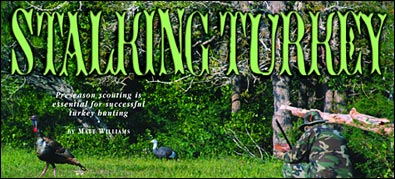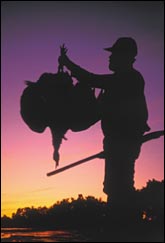
Preseason scouting is essential
for successful turkey hunting.
By Matt Williams
The spring eastern gobbler season is still more than a month down
the road for the 24 East Texas counties set to participate in
the year 2002. But if you're truly serious about bagging a mature
Tom during the the April 17-30 shotgun/archery only season, you'd
best get in a pro-active mode and start doing your homework right
now.
The essence of spring gobbler hunting is based on interacting
with the birds at a time of year when the desire to procreate
causes them to be vocal and overly curious.
Hunters most often use calls to mimic the sounds of a hen, thereby
arousing the gobbler's sex drive. Ideally, a gobbler that's high
on testosterone will respond to the sounds of a lovesick hen with
a raspy "gobble-gobble-gobble"-a resonant blast which
can be heard from a considerable distance on a crisp and still
spring morning. The idea at that point is to use one or more manually
or mouth-operated calls to lure a mature bird into shooting range-30
yards or less.
While it is entirely possible to go hunting "cold turkey"
and stumble across a responsive longbeard on opening morning,
the hunter who gets in the woods early and locates one or more
birds ahead of time will have a big advantage over the nimrod
who doesn't.
This holds especially true when hunting on public land, an abundant
resource in several of the East Texas counties where eastern gobblers
will be fair game for shotgunners and archers next month.
In all, there will be well over 400,000 acres of public land
available to spring turkey hunters this season, most of which
comes in the form of national forests, Corps of Engineers, state
wildlife management area properties or public hunting program
units.
While portions of the public land are lacking in viable turkey
habitat, others harbor some of the prettiest upland pine/hardwood
bottomland stands of timber found anywhere in the country.
The majestic easterns have responded well in these isolated pockets.
So well, in fact, that wild turkey gurus like John Burk of Nacogdoches
rate the public hunting opportunities available in eastern Texas
as good as or better than those found in Missouri and Arkansas.
 "Much of the public land in eastern Texas is literally crawling
with wild turkeys - it's as good as I've found anywhere in the country,"
notes Burk. "And what continues to amaze me is how underutilized
the resource is. I spend several days hunting on national forest
land each year and rarely come across another hunter. "Much of the public land in eastern Texas is literally crawling
with wild turkeys - it's as good as I've found anywhere in the country,"
notes Burk. "And what continues to amaze me is how underutilized
the resource is. I spend several days hunting on national forest
land each year and rarely come across another hunter.
"That's what makes the public hunting in East Texas so good,"
he adds. "The birds are just as plentiful here as they are
in Missouri and Arkansas, but there's only a small fraction of
the hunters competing for them."
Burk was bitten by the by the spring gobbler hunting bug many
moons ago. The bite was so infectious, in fact, that he went to
school and learned everything he could about the regal North American
game birds.
Burk's intensive schooling resulted in multiple college degrees
in wildlife biology with a major emphasis on eastern wild turkey
management. His background eventually lead to his being named
to the eastern wild turkey program of the Texas Parks & Wildlife
Department.
Bottom line is Burk knows eastern wild turkeys and he knows how
to hunt them in East Texas. Here's are some tips he dished out
in relation to preseason scouting:
The gobbling phenomenon
In order to hunt wild turkeys successfully in the spring, you
need to know what makes them tick.
According to Burk, there are two peak gobbling periods for wild turkeys. These periods are controlled entirely by "photo
periods"-the amount of daylight coming through the birds'
eye.
"The first peak gobbling period occurs once the hens reach
the necessary protein plateau in their nutritional intake to start
producing eggs," explains Burk. "When this occurs, the
hens start to show signs of being receptive to breeding. The gobbler's
testis enlarge based on hormonal releases from the photo periods,
which in turn triggers the first peak in gobbling activity.
"The second gobbling peak occurs when the hens start sitting
on nests," adds Burk. "That's when the gobblers are
actively looking for more receptive hens. During this period is
when the season in East Texas is prime to open."
Based on historic reports, gobbling activity around most of East
Texas is usually fairly moderate during the first week or so
of March. As the month drags on and days grow longer, however,
the birds become increasingly vocal.
"I always get more turkey sighting reports during early
March than I do reports of gobbling birds," explains Burk.
"But that usually begins to change toward the end of the
month. In my opinion, that's the best time to start scouting.
Your chances of getting the birds to respond are a lot better
and you run less of a risk of burning yourself out or writing
a good area off before the season gets here."
continued
page 1 / page 2
| 
